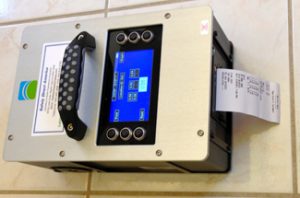Comparing ASTM C1028 with ANSI A137.1/A326.3 for Floor Slip Resistance Testing – SCOF vs. DCOF
Requirements for a minimum slip resistance for tiled indoor wet areas (pool decks, showers, some lobbies, commercial kitchens, etc.) entered the International Building Code (IBC) in 2012 when the American National Standards Institute (ANSI) amended their standard A137.1 to include a minimum value for wet dynamic coefficient of friction. It’s important to know what this means when you are buying tile.
The 2012 IBC says, “2103.6 Ceramic tile. Ceramic tile shall be as defined in, and shall conform to the requirements of, ANSI A137.1.” The latter specifies a minimum dynamic coefficient of friction of 0.42 for level indoor areas that may get wet in use. It doesn’t say what a safe level of coefficient of friction would be.
The test in the ANSI standard is sometimes known as the DCOF Acutest, or DCOF Rating test. It uses the BOT-3000E digital tribometer and water with a trace of a specified wetting agent, or “detergent.” The concentration of the wetting agent is a key factor in this test. In 2018, ANSI released the A326.3 DCOF Rating Slip Test, which uses the same test method and was an update to and replacement for A137.1.

BOT-3000E used in ANSI A326.3 and ANSI A137.1 tile slip tests
In limited studies done at Germany’s University of Wuppertal, the BOT-3000E was shown to correlate well with human traction when the concentration of the wetting agent was 0.10%. Using a wetting agent ensures that the flooring will be uniformly wetted for the test, and simulates the trace of detergent residue on a typical indoor floor that’s sometimes cleaned with a detergent solution. It also leads to lower values of the measured DCOF, since it makes the water more slippery. Unfortunately, this is not the wetting agent used in the American ANSI A326.3 floor DCOF test. For no other discernible reason other than it makes the DCOF readings higher, the TCNA decided to use 0.05% of the wetting agent instead of the 0.10% used in the German study.
The German study indicated that a minimum DCOF greater than 0.42 had an acceptably low risk of slipping for walking pedestrians for indoor level floors. But the German study used the test method described in the now-expired ANSI B101.3, and the test method there made it harder to get above the 0.42 threshold. Also, changes have been made to the machine since the German research was done. The German research said nothing about outdoor floors, pool decks, ramps, and anything other than indoor level floors, such as lobbies and restrooms, which don’t usually require a great deal of wet slip resistance.
The U.S. tile industry, through Tile Council of North America (TCNA), did their own research and halved the concentration of wetting agent to give higher DCOF values, but retained the same minimum DCOF of 0.42 for ANSI A137.1/A326.3. This had the advantage of making more of their slippery tiles meet the minimum. “TCNA researchers found on average that 0.60 SCOF measured with de-ionized water generally correlated with 0.38 DCOF when measured with slightly soapy water.” The SCOF test method ASTM C 1028 has been withdrawn by ASTM; it had very poor reproducibility and was also a misleading failure at predicting pedestrian slips. So if you can’t trust ASTM C018, which was promoted by the TCNA to help sell slippery tile, then you’d be a fool to trust their ANSI A326.3, which according to them has a fairly good correlation with the highly misleading and utterly useless and withdrawn C1028.

Withdrawn ASTM C1028 SCOF test. This what TCNA was promoting before ANSI A326.3
ANSI and TCNA added some 16 factors that the tile specifier must consider in the ANSI A326.3 tile DCOF rating tes. Unfortunately they have given no guidance as to account for these factors. TCNA only states that the relevant ANSI A137.1 section “should be reviewed carefully by anyone involved in the specification process before picking the right tile for the next job.”
So what will you do to “pick the right tile for the next job”? We recommend using the situation-specific safety standards discussed on the reliable slip resistance testing page. Don’t be found negligent by a jury because you didn’t consider the 16 factors that you needed to worry about!
ANSI B101.3 mentions a second, much lower, DCOF limit: 0.30. From 0.30-0.45 is “acceptable – increased probability of slipping. Monitor DCOF regularly and maintain cleanliness. Consider traction enhancing products and practices where applicable for intended use.” Below 0.30, “seek professional intervention. Consider replacing flooring and/or coating with high traction products.”
Two more things to remember: first, the BOT-3000E is not suitable for testing outdoor flooring because of its low speed; people may be running outdoors, especially when it’s raining. The German research did not evaluate flooring other than those floors intended to be used in flat indoor situations. It’s the TCNA that decided to use the ANSI A326.3 for outdoor floors (and barefoot areas) without doing any further reliable and peer-reviewed research with the BOT-3000E. The rubber used on the BOT-3000E is quite hard and NOTHING like a bare foot. Second, indoor flooring that’s slippery wet can be fine if it’s kept dry.
For reliable slip resistance testing based on real-world slip and fall research conducted around the world, visit SafetyDirectAmerica.com/Floor-Friction-Testing
